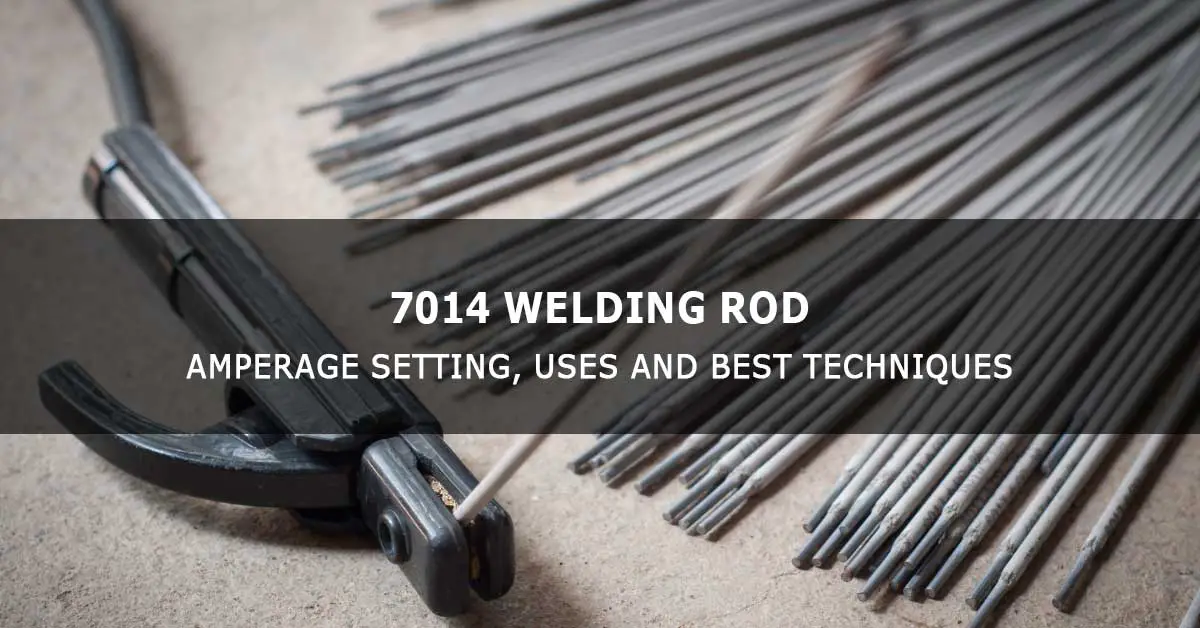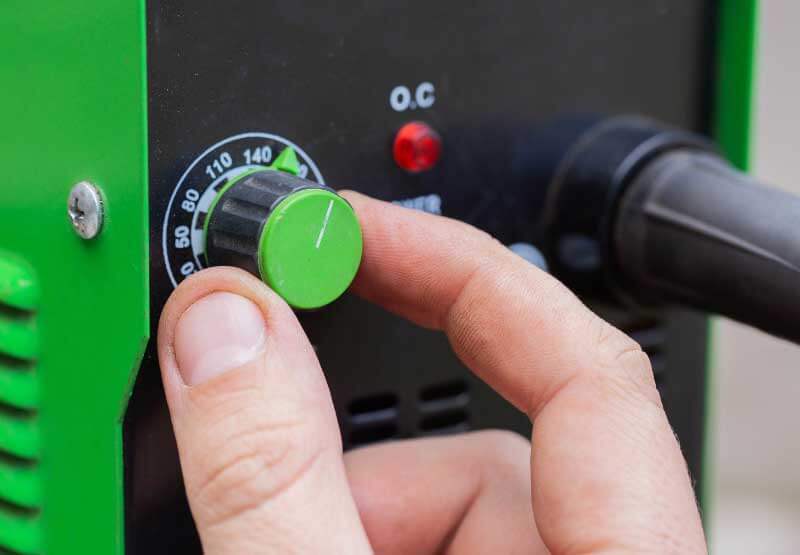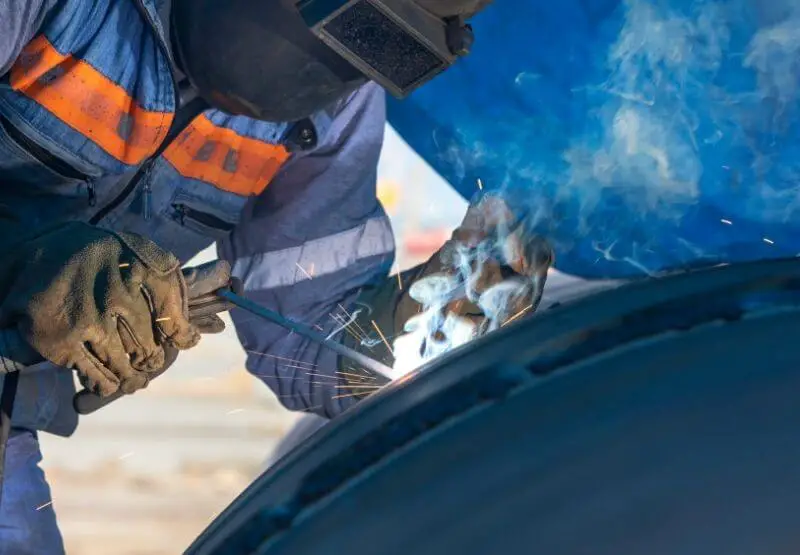The 7014 welding rod is a multipurpose stick welding electrode, popular among beginners and professionals. It can be used for all types of steel and is highly versatile due to its tensile strength, polarity, and other properties.
The 7014 welding rod is composed of low-hydrogen iron powder, making it an ideal choice for welders due to its easy arc strikes and smooth slag removal. When properly used, the 7014 welding rod will enhance your welding projects with superior quality results.
Let’s dive deeper into understanding this electrode, from amperage settings to best techniques, so you know exactly how to approach your next project!
Brief about 7014 welding rod
The electrode code E7014 indicates the following:
E– Electrode for SMAW process.
70– Minimum ultimate tensile strength is 70,000 psi. (Minimum yield strength is 58,000 psi. The elongation percentage is 17 %.).
1– Indicates this rod is suitable for welding in all positions (flat, horizontal, vertical, and overhead).
4– Indicates the flux coating type’ iron powder Titania (Rutile)’ and the current used ‘DCEP, DCEN, or AC.
Chemical composition of welding electrode E 7014
| Chemical composition of welding electrode E 7014 | ||||
| Carbon 0.15 % max. | Manganese 1.25% max. | Silicon 0.9 % max. | Phosphorous 0.035 % max. | Sulfur 0.035 % max |
| Nickel 0.30 % max. | Chromium 0.20 % max. | Molybdenum 0.3 % max. | Vanadium0.08 % max. | |
Some welding parameters for E 7014 electrode
| Some welding parameters for E 7014 electrode | |||
| Welding rod diameter in inches | Type of power | Amperage range | Volts range |
| 3/32ʺ | DCEP, AC, or DCEN | 70-90 | 26-29 |
| 1/8ʺ | DCEP, AC, or DCEN | 120-145 | 26-27 |
| 5/32ʺ | DCEP, AC, or DCEN | 140-210 | 26-28 |
| 3/16ʺ | DCEP, AC, or DCEN | 180-280 | 26-28 |
7014 is a popular electrode since it is simple to use, can be used with DC or AC, and has superb welding characteristics. It is an all-position electrode.
The advantages and characteristics of the 7014 rods
- 7014 is a rutile electrode, and the flux coating contains iron powder for higher deposition and can work with higher welding speeds.
- 7014 is good for depositing heavy weld beads and can be used with DCEP, DCEN, and AC polarities.
- 7014 has a tensile strength of 70,000 psi
- 7014 is one of the very versatile stick welding rods and is popular with DIY enthusiasts and professional welders. It is easy to use, even for a beginner welder.
- 7014 is a fill-freeze and drag type electrode that produces a stable arc and an easily removable slag (often the slag falls on its own), and the weld beads are smooth with a fine wavy look, flat, and look good.
- 7014 can be used for single-pass as well as multi-pass welds.
- 7014 rod is normally used for welding low-carbon and mild steel alloys and works well even for bad-fitting base metals.
- 7014 is good for applications like structural steel constructions, shipbuilding, metal bridges, automobile bodies, etc.
- The weld quality is good, and it has reasonably good strength.
- 7014 is a fill-freeze type of electrode. While it is good for flat and horizontal welding positions, using it for overhead and vertical welding can be tricky. Hence it is not a preferred rod for welding in the vertical or overhead position.
- 7014 welding rods are considered average or medium penetration electrodes. The travel speed depends on the base metal thickness and the amperage setting.
- 7014 rod is very comfortable when you are striking or re-striking arcs.
- 7014 is not a low hydrogen rod and does not absorb much moisture, so oven drying is not mandatory. This makes it good for outdoor jobs under damp conditions. However, it gives a better welding quality and easy slag removal when the rods are stored in an airtight container or taken from a freshly opened pack.
- 7014 is popular with farmers because of its ease of use and the good strength of the weld bead.
- Professional and DIY welders who create artifacts appreciate this electrode due to its low penetration and nice ripples on the weld bead.
7014 Welding rod amperage setting, uses, & best techniques
Amperage setting
Correct amperage setting for the welding job is very important, and in most cases, it can contribute to a good or bad weld. An incorrect amperage setting can lead to welding defects like more slag, spatter, and low-quality weld beads.
The amperage setting for a welding job is based on the suggested range of amperage for the electrode size, the thickness of the base metals and their temperature (if they are preheated or very cold), and the welding position.
The thumb rule is that the amperage required for the welding job increases with the increase in the welding rod diameter. The reason is simple; a higher-diameter welding rod needs more heat to melt the metal core and the flux.
Selecting the perfect amperage comes with experience, and for beginners, it is advisable to do a small trial job before welding the project job. You can refer to the printed label on the electrode box for the suggested amperage range by the welding rod manufacturer.
The connection between the welding rod diameter, base metal size, and amperage
The diameter of the welding rod increases with the increase in base metal thickness since thicker base metals need a higher rate of weld metal deposition. And obviously, a higher-size electrode needs higher amperage to melt it.
The converse of the above is also true. When welding thinner base metal, you should use a lesser-diameter rod and low amperage. If you set high amperage for welding thin base metal, the result can be warping of the base metal and blow holes. The general rule is never to use a thicker welding rod than the base metal.
The suggested welding rod diameter v/s base metal thickness is compiled in the following table. However, this is only suggestive, and things can change based on other considerations like welding thin base metals and automobile body parts, etc.
| Sl. no. | Electrode diameter in inches | Metal thickness in inches |
| 01 | 3/32ʺ | 3/32ʺ to 3/16ʺ |
| 02 | 1/8ʺ | 1/8ʺ to 1/4ʺ |
| 03 | 5/32ʺ | 1/4ʺ to 3/8ʺ |
| 04 | 3/16ʺ and 7/32ʺ | More than 3/8ʺ |
The connection between welding rod size, amperage, and welding position
The amperage selection becomes easy once you select the welding electrode size for your project. The rod size is mainly based on the base metals’ thickness but also relates to the welding position.
In the case of vertical welding or welding in an overhead position, some welders may prefer to use a lower size rod to control the weld puddle (a lower size rod enables the welder to use low welding speed). However, this is not mandatory, and expert welders use the welding rod size compatible with the base metal thickness and still get a smooth bead and a good weld bead in any welding position.
Suppose you are using the same rod size for welding in all positions. In that case, the amperage setting for the vertical weld and overhead position weld will be marginally less (5 to 10%) than for welding in the flat or horizontal position. The aim should be to keep the heat generated from the welding electrode the same in all welding positions.
The connection between base metal temperature and the amperage
The temperature of the base metal is a factor to be considered for setting the amperage. A very cold base metal can make it difficult to strike the arc, and it may be wise to heat it to room temperature or allow it to attain room temperature. In the same way, if the base metal is warmed up for procedural reasons, it may require amperage to be set at the lower end of the range.
Even if you set the amperage after considering all the factors discussed above, how can you be sure that the set amperage is correct? Well, this can be a problem for a beginner welder. However, experienced welders can judge whether the amperage setting is correct by looking at the slag, spatter, welding arc, weld puddle, and, finally, the quality of the weld bead. Also, if you are using a cheap welding machine, its output current may vary from the settings done by you.
The indications of a low amperage setting can be
- Uneven and bad-looking weld beads.
- It is normally easy to strike the arc with a 7014 rod, but a low amperage makes it difficult.
- Reduction in deposition rate due to low heat (low amperage). And this reduces the welding speed also.
- A dim welding arc with erratic sound.
The indications of a high amperage setting can be
- Increase in spatter and slag formation.
- A bright welding arc with erratic sound.
- Difficulty in controlling the molten weld puddle.
- Wider weld bead.
- You may have to increase the welding speed.
Welding techniques recommended by experienced welders for E7014
- 7014 electrode has iron powder in the flux coating, and a proper drag angle may help push the molten slag to the back of the weld puddle.
- When welding in an overhead position with a 7014 rod, maintain a good welding speed to avoid spilling and use current at a lower or mid-range setting.
- 7014 rod is good for sheet metal and automobile body parts welding. Between 7014 and 7018, 7014 strikes the arc better on thinner metal sheets, and the high deposition rate enables faster welding speed.
- Keep the electrode diameter a step thinner for welding base metal thickness up to 3/16ʺ.
- When doing vertical or overhead welding, it is advisable to set the current to the lower end of the range for DCEN and the mid-range for AC. The current can be increased in small increments till you reach the ideal current. It is better to follow a triangular weave technique when doing vertical-up welding.
Conclusion
7014 rod is popular among professional, DIY, and even beginner welders. This electrode’s typical applications are welding ship structures, bridges, buildings’ structural steel, ornamental iron, auto bodies, fenders, storage tanks, machine parts, and many more.
We hope this article has given sufficient information to you about 7014 rods.
Continue Reading: A Guide To 6010, 6011, 6013, And 7018 Welding Rods.
References







